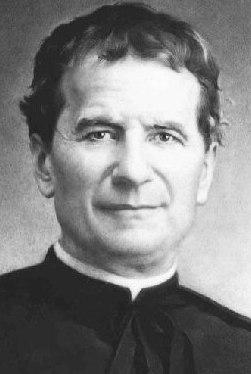 St. John Bosco
St. John Bosco
Scripture: Lectionary # 320. Hebrews 10:19-25. Psalm 24:1-2,3-4. 5-6. Mark 4:21-25:
We are fortunate to have chapter four of Mark for our liturgical readings this week. He is said to have followed St. Peter, one colossal figure, who was following another colossal figure, Jesus; Mark is the third colossal figure and we are privy to his inspired insights into the words and deeds of Jesus. This fourth chapter is a collection of the sayings of Jesus that he drew from an oral tradition and faithfully handed them on to us in his short but clear and dynamic Gospel. In studying or meditating on parables, we should start with Mark.
We hear the living voice of Jesus in today’s selection which is a continuation of a string of parables—simple comparisons taken from the ordinary life of a person of the first century. Their simplicity adds to the fact that they are meant to make us think in a new way and to put that thinking into action. Mark does not hide his light under a bushel, but allows it to shine and present us the image and face of Jesus together with his living voice. We need to read over and over again this chapter in order to get a feel for how Jesus speaks in parables and how the believers in Mark’s community learned how to adopt them to their specific needs for change of heart and mind ( a wholesome “metanoia.”)
The call of Vatican II beckons us to not only meditate on Scipture but also to read the signs of the times. What Jesus is doing with the parables is getting his disciples and followers to do that in their time by facing their ordinary life and giving it a new dimension because of his preaching, teaching, and healing. Parables help us to read the signs of the time in our day. They force us to rethink our journey of life and to take some new paths in our spiritual life. Day by day we are encouraged to increase that faith a thirty-fold, a sixty fold, and a hundred fold. Progress is part of parable language. There is movement and no stagnancy within them.
Mark has given us a good overview on parables in chapter four. There are three parables to start (verses 3-9, 26-29, 30-32). The Parable of the Sower is interpreted allegorically in Jesus’ explaining it to his disciples in verses 13-20, and verse 33. Finally, we have two parables that show us the process of revelation (verses 21-25). These are the layers in the text that Mark gives us on parables.
Unlike Matthew, Mark focuses first and foremost on Jesus in the way he presents the parables. Matthew directs his attention to the kingdom. For Mark Jesus is always the center of our attention as he leads us to see that this Gospel is a Gospel of the Cross.
We, like the disciples of Jesus, need to discover how to read the signs of the times in these clear, simple, and homely examples. The lamp makes us think of Jesus who is burning brightly and is meant to be seen; we are not to be silent about who he is in our lives. Like Mark we need to place our full attention of mind and heart on Jesus. We are to be like Jesus—lights shining in the darkness and not hidden under a table or a bushel basket.
The Church and our faith communities help us to learn and love what Jesus is saying to us in plain speech as well as in his parables. Faith sharing helps us to experience Christ who is the light of the world and to not curse the darkness but keep our lights burning for others. May the light of Christ always burn brightly. Amen.
Copyright 2013 Fr. Bertrand Buby, S.M.
About the Author

Guest
We welcome guest contributors who graciously volunteer their writing for our readers. Please support our guest writers by visiting their sites, purchasing their work, and leaving comments to thank them for sharing their gifts here on CatholicMom.com. To inquire about serving as a guest contributor, contact editor@CatholicMom.com.


.png?width=1806&height=731&name=CatholicMom_hcfm_logo1_pos_871c_2728c%20(002).png)
Comments